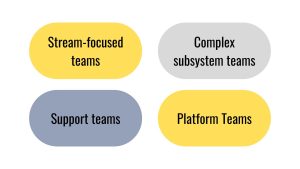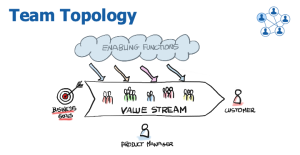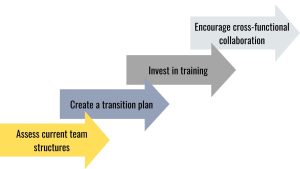Team Topologies: DevOps Beyond Technical Excellence
Introduction Today’s technology landscape is constantly evolving. Companies are constantly looking to adapt their software development and operations processes to stay ahead. ...

Introduction
Today’s technology landscape is constantly evolving. Companies are constantly looking to adapt their software development and operations processes to stay ahead. DevOps emerged as a transformative approach that connects development and operations to deliver software faster and more reliably. However, adopting DevOps is more than just a technical feat. It also involves changing the structure and dynamics of teams to maximise efficiency, collaboration, and innovation. This is where team topologies play a critical role.
Understanding Team Topologies: A New Perspective
Team topologies refer to the strategic structuring and interaction of teams within an organisation. They shape how teams communicate, collaborate, and create value. Unlike traditional hierarchies or static team structures, team topologies promote flexibility, adaptability, and continuous information flow. The core idea is to design teams that are not only technically savvy, but also able to collaborate seamlessly.
Organisations that use effective team topologies create fertile ground for success. This goes beyond code and deployment pipelines; it’s about people, processes, and culture. By rethinking team structures, companies can achieve optimal alignment between business goals and technology implementation.
Four Fundamental Team Topologies
In their influential work, Matthew Skelton and Manuel Pais identified four key team topologies that support DevOps and modern software delivery.

- Stream-focused teams: These teams focus on delivering value that meets specific business opportunities or customer needs. Their scope includes end-to-end ownership of a product or feature, from development to deployment. Stream-focused teams minimise dependencies and facilitate faster feedback loops.
- Support teams: These teams help other teams adopt new technologies, processes, or skills. They act as internal consultants, providing expertise and support without directly owning the product. This helps organisations share best practices and build the confidence of stream-focused teams.
- Complex subsystem teams: Sometimes a system requires deep domain expertise, such as machine learning models or complex algorithms. Complex subsystem teams handle these specialised parts of the system, allowing other teams to focus on broader goals without getting bogged down in complexity.
- Platform Teams: These teams build and maintain the core services and infrastructure that other teams rely on. Their mission is to simplify the work of teams working on a flow-based approach by providing reliable and reusable tools, ensuring that developers can focus on building products rather than inventing new infrastructure.
Why Team Topologies Matter in DevOps
DevOps, at its core, is about improving collaboration between development and operations. However, a common mistake is focusing too much on tools and pipelines while ignoring how teams are structured and interact. Properly implemented team topologies bridge this gap by fostering a culture of shared accountability and continuous learning. For example, a company may have adopted DevOps practices but struggle with slow releases due to frequent bottlenecks. This problem often arises from teams that are too dependent on each other or are not aligned with product goals. By reorganising teams to fit topologies that are aligned with flows or platforms, companies can break down silos and improve workflow.
Benefits of Adopting Team Topologies
- Reduced Friction and Bottlenecks: Clearly defined team structures and responsibilities minimise the need for constant handoffs and lengthy coordination. Flow-aligned teams, supported by the platform and supporting teams, can work independently while ensuring quality and consistency.
- Faster Time to Market: When teams are autonomous and aligned with business goals, they can iterate faster. Platform teams further accelerate development by offering optimised access to infrastructure and shared services.
- Continuous Learning and Innovation: Supporting teams encourage a culture of experimentation and knowledge sharing. This not only boosts morale, but also drives innovation as teams feel empowered to try new approaches without fear of failure.
- Better Resilience: When specialised teams handle complex subsystems, the organisation as a whole becomes more resilient. Flow-aligned teams can focus on building and delivering features, knowing that experts are handling the most complex parts.

Moving Beyond Technical Excellence: Building a Culture of Trust
Adopting a team topology is not just a technical shift. It requires organisations to create a culture of trust and collaboration. Leaders must prioritise open communication and provide clarity around roles and expectations. Teams must understand their purpose and how they contribute to the big picture. This alignment increases motivation and ensures that everyone is pulling in the same direction. A culture that supports learning is also essential. Facilitating teams thrive when other teams are open to their input. Likewise, platform teams are more effective when they receive ongoing feedback from users. By promoting an open mindset, organisations can foster an environment where improvement is a shared responsibility.
Challenges in Implementing Team Topologies
Despite their benefits, implementing team topologies is not without its challenges. The shift from traditional hierarchies to more dynamic structures can be met with resistance. Employees may feel unsure about the change, especially if they are used to rigid roles.
To overcome this, leaders should take a phased approach:
- Start with clear communication: Make sure everyone understands the purpose and benefits of the new structure.
- Pilot the change: Start with one or two teams as an experiment, allowing them to test new ways of working and gather feedback.
- Iterate and adapt: Use insights from pilots to refine the approach before scaling.
Practical Tips for Getting Started

- Assess current team structures: Map out your existing teams and identify any bottlenecks or dependencies that are slowing down progress. Find areas where teams can be more autonomous or better aligned with product goals.
- Create a transition plan: Develop a plan to migrate from your current team structures to the new topologies. Set realistic timelines and be prepared to adjust as needed.
- Invest in training: Equip your teams with the knowledge and skills they need to excel in their new roles. This could include technical training for platform teams or workshops on effective collaboration for all teams.
- Encourage cross-functional collaboration: Build bridges between teams. This could include regular check-ins or cross-team projects that foster a sense of shared purpose.
Conclusion
Team topologies offer a framework for taking DevOps to the next level. By focusing not only on technical excellence but also on strategic team collaboration, organisations can unlock new levels of productivity and innovation. The key is to structure teams in a way that fosters autonomy, reduces friction, and supports continuous learning.
In this way, companies not only optimise their processes, but also create a resilient, collaborative culture that can adapt to any challenges that come their way. As DevOps continues to evolve, team topologies will become a critical component in ensuring sustained success.